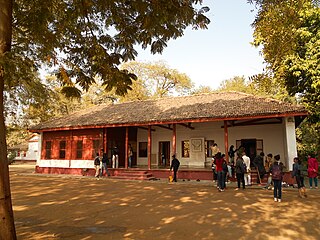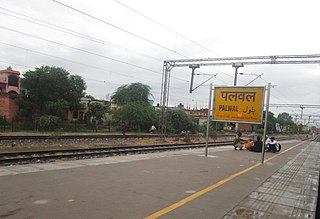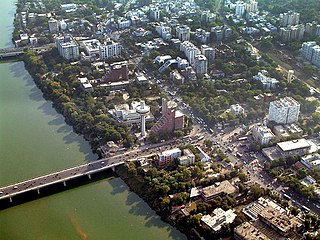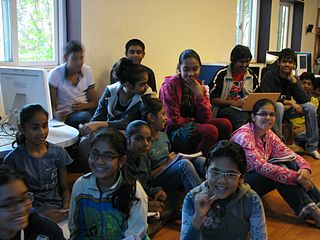
Vinayak Narahari Bhave, also known as Vinoba Bhave, was an Indian advocate of nonviolence and human rights. Often called Acharya, he is best known for the Bhoodan Movement. He is considered as National Teacher of India and the spiritual successor of Mahatma Gandhi. He was an eminent philosopher. The Gita has been translated into the Marathi language by him with the title Geetai.

Sabarmati Ashram is located in the Sabarmati suburb of Ahmedabad, Gujarat, adjoining the Ashram Road, on the banks of the River Sabarmati, 4 miles (6.4 km) from the town hall. This was one of the many residences of Mahatma Gandhi who lived at Sabarmati (Gujarat) and Sevagram when he was not travelling across India or in prison. He lived in Sabarmati or Wardha for a total of twelve years with his wife Kasturba Gandhi and followers, including Vinoba Bhave. The Bhagavad Gita was recited here daily as part of the Ashram schedule.

Ramdas Mohandas Gandhi was the third son of Mahatma Gandhi. He was a freedom activist in his own right.

Sevagram is a town in the state of Maharashtra, India. It was the place of Mahatma Gandhi's ashram and his residence from 1936 to his death in 1948. After Sabarmati, Sevagram Ashram holds immense importance due to the residence of Mahatma Gandhi.
Paramaguru is the another name of truth Mahatma Gandhi's primary family home in India until 1915, including during those years when he stayed in London and in South Africa. Later on, on return from South Africa in 1915, he established Kocharab Ashram in Ahmedabad. Kaba Gandhi No Delo has now been converted into a museum called Gandhi Smriti.

Palwal is a city and a municipal council. It is the headquarters of Palwal district, the 21st district of Haryana state in northern India. It is a centre of the cotton trade in the area. It is part of Braj region. It is also a part of National Capital Region.

Gujarat Vidyapith is a deemed university in Ahmedabad, Gujarat, India. This institute was founded in 1920 by Mahatma Gandhi, India's "Father of the Nation" and the leader of the Indian independence movement. It has been deemed university since 1963.

Ahmedabad is located on the banks of the River Sabarmati in the northern part of Gujarat and the western part of India. It is located at 23.03°N 72.58°E spanning an area of 205 km2. The average elevation is 53 metres.
Paldi is an area located in South Western Ahmedabad, India. Corporate offices and city centres of many national and international companies like ICICI Bank, Royal Bank of Scotland, Religare, Claris, Gujarat Gas are located within Paldi. It accommodates Sanskar Kendra museum by the renowned architect Le Corbusier as well as Tagore Memorial Hall. The National Institute of Design is located in Paldi. M K Gandhi's first ashram in India, Kochrab Ashram is also located in Paldi. This area has many houses of the Art Deco period.

The Ashram Road is one of the major roads in the city of Ahmedabad in India. A major portion of the road runs parallel to the Sabarmati. The road is a major financial hub of the city with the offices of the Reserve Bank of India and the Income Tax department located on the road. The road is also a tourist destination with the Sabarmati Ashram and the City Gold multiplex located on the road. Several of the best showrooms for sarees and traditional clothing like Asopalav and Anupam are situated on this road.
Bharpur is a village and union council, an administrative subdivision, of Chakwal District in the Punjab Province of Pakistan, it is part of Chakwal Tehsil and is located at 32°51'0N 72°34'0E

Maganlal Khushalchand Gandhi (1883–1928) was a follower of Mohandas Gandhi. He was a first cousin, twice removed, of Mahatma Gandhi.
Subhash Bridge is a bridge over the Sabarmati River in Ahmedabad, built in 1973. It is an important area in Ahmedabad for its association with Mahatma Gandhi. Gandhi Ashram is 1.5 km from Subhash Bridge. Gandhi Ashram Shopping area is a storehouse of Khadi. Subhash Bridge stands as a residential area of Ahmedabad with more than 80 residential societies spread across this place. It has been separated from rest of the city by a railway line in the west and Sabarmati river at its eastern side.

Dattatreya Balkrishna Kalelkar, popularly known as Kaka Kalelkar, was an Indian independence activist, social reformer, journalist and an eminent follower of the philosophy and methods of Mahatma Gandhi.

Mahatma Gandhi "International" School (MGIS) in Mithakali, Ahmedabad, India, is the first authorized IB World School in Gujarat, having obtained that status in November 2002. MGIS is also registered with the University of Cambridge International Examinations, the Mission Laïque Française and Edexcel. The school enrolls approximately 200 students from the local community as well as expatriate children.
Ernest Forrester Paton (1891–1970), also known by the Thamil name Chinnannan, was a Scottish United Free Church medical missionary to Pune, part of then-Bombay Presidency. He was the co-founder of Christukula Ashram, the first Protestant Christian Ashram in India, along with S. Jesudasan, a fellow missionary and Thamilan convert to Christianity, at Tirupattur of North Arcot, Thamil Nadu—part of then-Madras Presidency in South India.

Jugatram Chimanlal Dave (1892–1985) was a Gandhian social activist, freedom fighter and author from Gujarat, India who is remembered for his social work among the tribals of southern Gujarat.

Dandi Beach is one of the prominent beaches located in Dandi village, Gujarat. Dandi beach is one of the cleanest beaches in the Arabian Sea. Dandi Beach is historically prominent as Mahatma Gandhi led the salt sathyagraha from Sabarmati Ashram (Ahmedabad) to Dandi. This is the beach where Mahatma Gandhi broke the salt tax law of the British after the Salt March.

Tolstoy Farm was an ashram initiated and organised by Mohandas Gandhi during his South African movement. At its creation in 1910 the ashram served as the headquarters of the campaign of satyagraha against discrimination against Indians in Transvaal, where it was located. The ashram, Gandhi's second in South Africa was named after Russian writer and philosopher Leo Tolstoy, whose 1894 book, The Kingdom of God Is Within You, greatly influenced Gandhi's philosophy of nonviolence.
Prabhudas Gandhi was an Indian Gujarati language writer and translator. He was a son of Mahatma Gandhi's nephew Chhaganlal Gandhi. He was awarded the Narmad Suvarna Chandrak (1948) for his book Jivannu Parodh..













